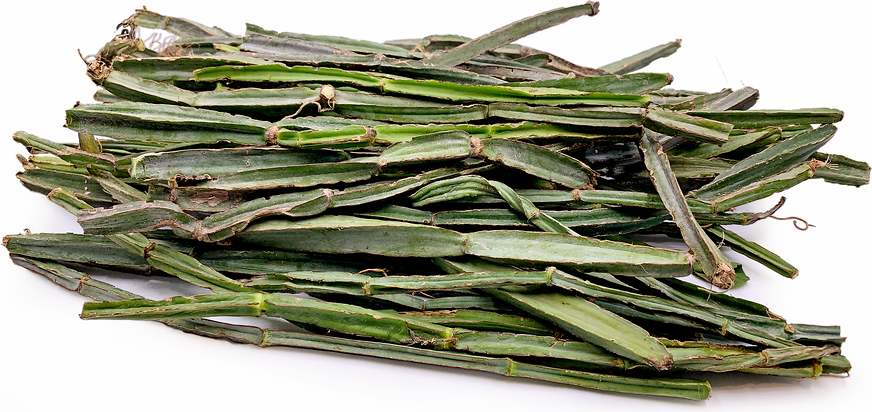


Pirandai
Estimated Inventory, lb : 0
Description/Taste
Pirandai has long, slender, quadrangular stems, averaging around 1 meter in length and 1-2 centimeters in diameter. The green stems are rubbery to the touch and are thick and succulent. Each stem is segmented by many nodes with small leaves, and curly tendrils may appear at the tips of the stems. When Pirandai stems are peeled, they reveal a bright green, jelly-like flesh. Pirandai is tender with a pungent and highly acidic flavor.
Seasons/Availability
Pirandai is available year-round.
Current Facts
Pirandai, botanically classified as Cissus quadrangularis, is a perennial plant belonging to the grape family. Also known as the Adamant Creeper, Veldt grape, Four-angled vine, Devil’s Backbone, Patah Tulang, and Hadjora, Pirandai stems are widely used as a medicinal herb in traditional medicine. The stems are also used in culinary preparations, but Pirandai stems must be soaked and cooked as they contain oxalate crystals which can cause an uncomfortable itching sensation in the throat and mouth.
Nutritional Value
Pirandai contains vitamin C and vitamin E and is also a rich source of calcium.
Applications
Pirandai can be used in both raw and cooked applications. Before it can be used, the leaves, tendrils, and lower stems must be removed leaving only the top three, tender segments to be cooked. The stem’s tough outer layer also needs to be peeled away, and the flesh is then cut into bite-sized pieces. Pirandai stems are commonly used to make chutney, pickles, and pastes. They can also be fried and served as a side dish. Pirandai pairs well with turmeric, garlic, onions, dried chiles, sesame seeds, tamarind, curry leaves, coconut, and yellow lentils. Pirandai will keep up to two weeks when stored in the refrigerator.
Ethnic/Cultural Info
Pirandai was mentioned in the Bhawa Prakash, a classic text used for Ayurvedic medicine, written around 1550 CE. In traditional medicine, Pirandai is used to reduce swelling, as a pain reliever, as an aid for digestion, and to help relieve wounds and burns. Pirandai is also believed to help with recovery from injured ligaments, sprains, and broken or fractured bones.
Geography/History
The origins of Pirandai are relatively unknown, but it is believed to be native to Bangladesh, India, or Sri Lanka and has been growing wild since ancient times. Today, Pirandai can be found in home gardens and specialty retailers in Africa, India, Sri Lanka, Indonesia, Vietnam, Malaysia, Thailand, the Philippines, Brazil, and the United States.
Recipe Ideas
Recipes that include Pirandai. One
| Kannamma Cooks |
|
PIRANDAI THUVAIYAL |
| YouTube |
|
Pirandai Soup |
| YouTube |
|
Pirandai Roti |
| YouTube |
|
Pirandai Pickle |




